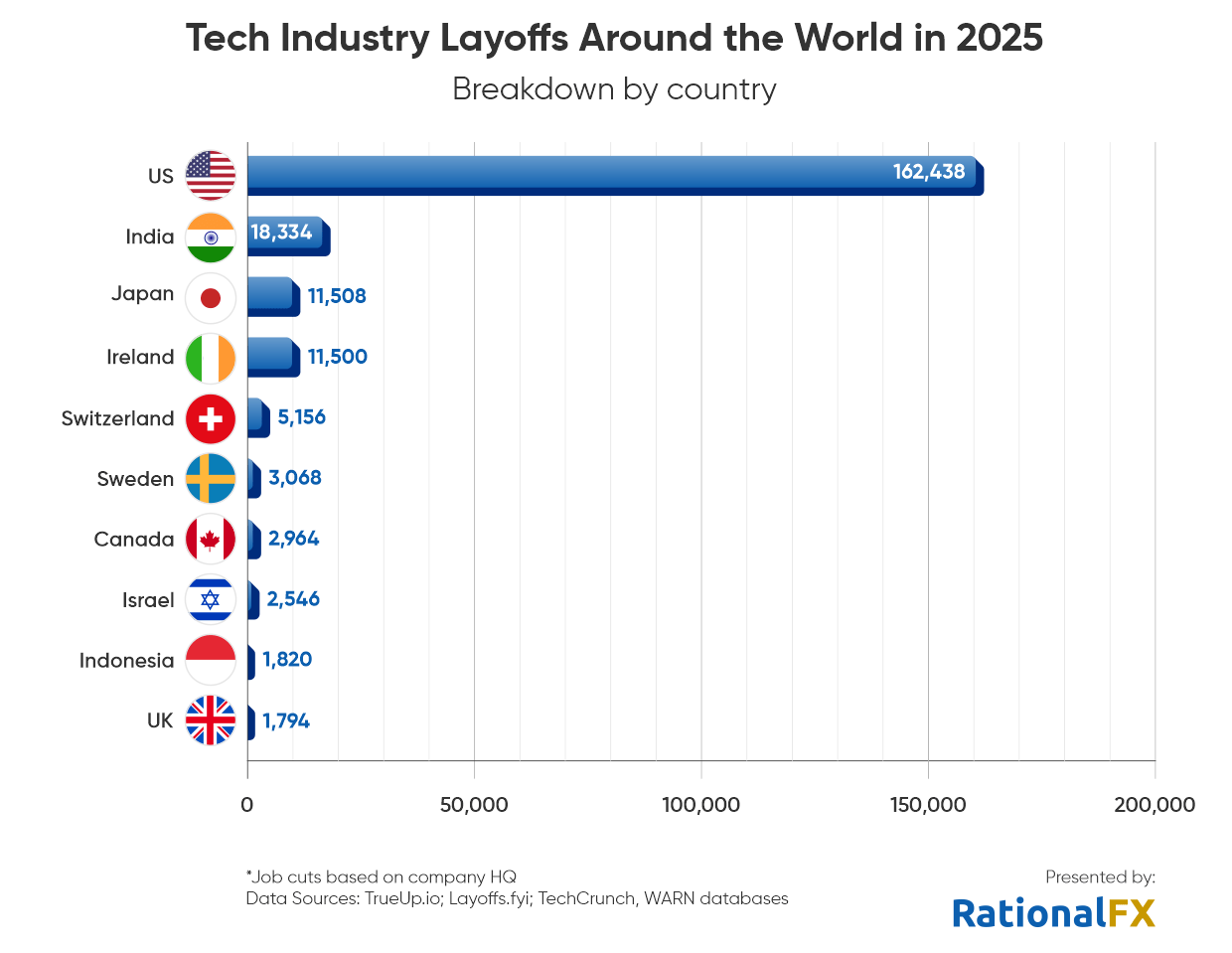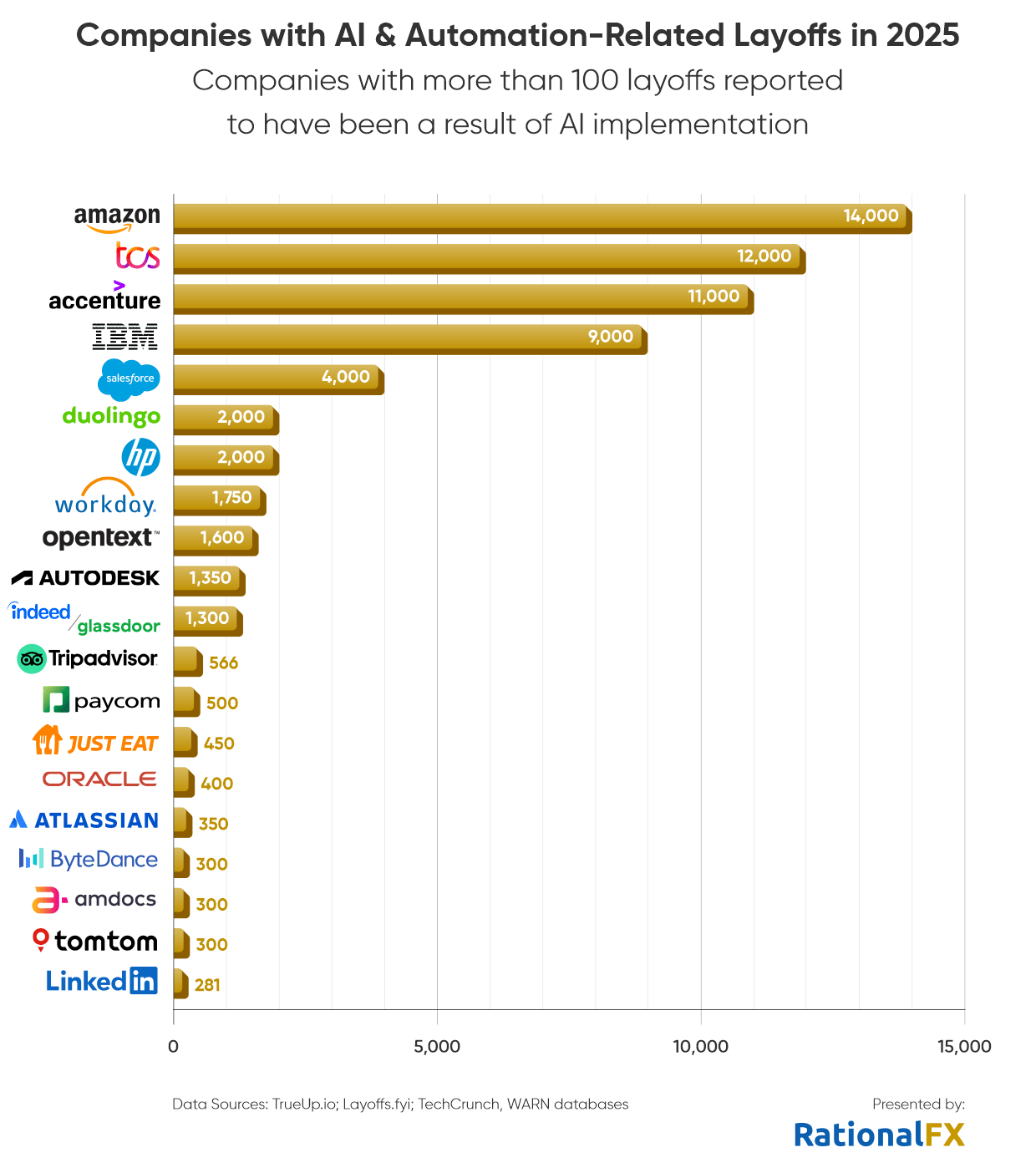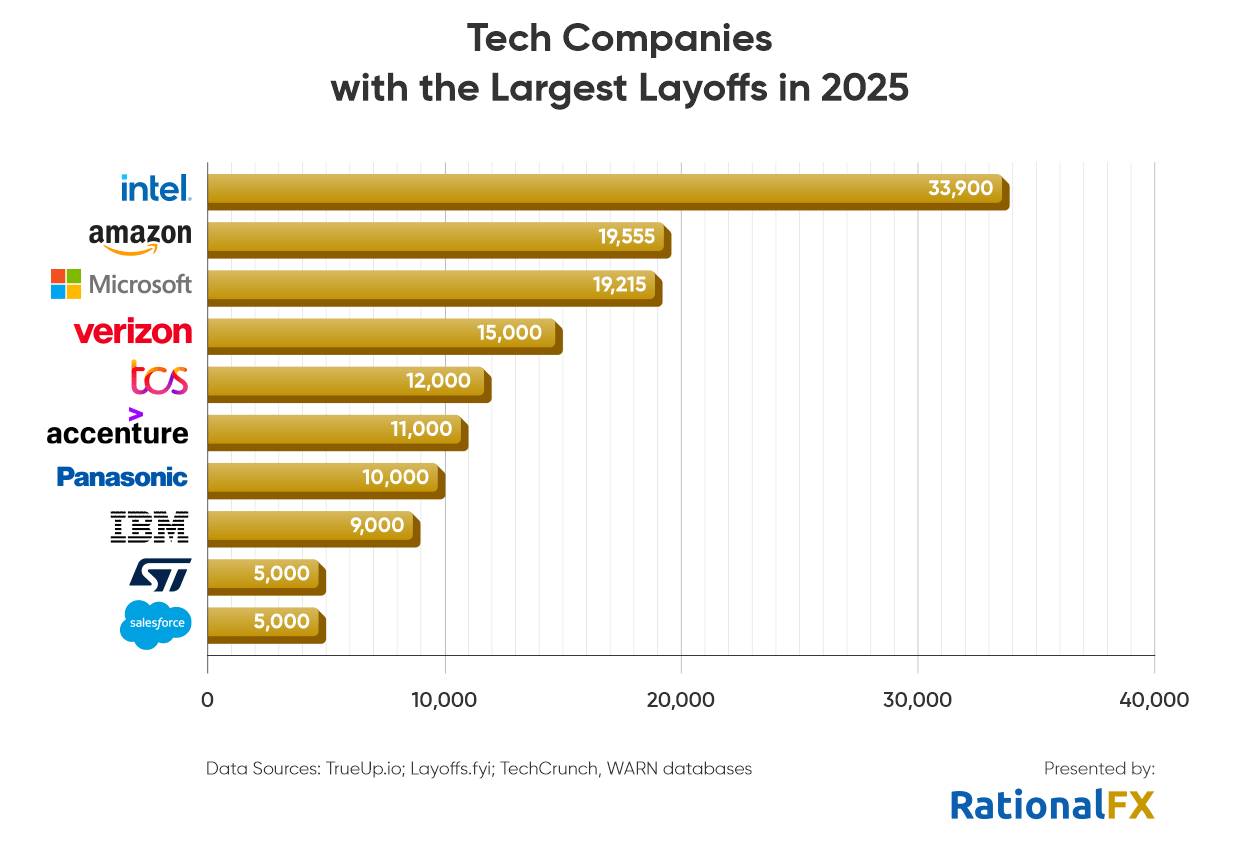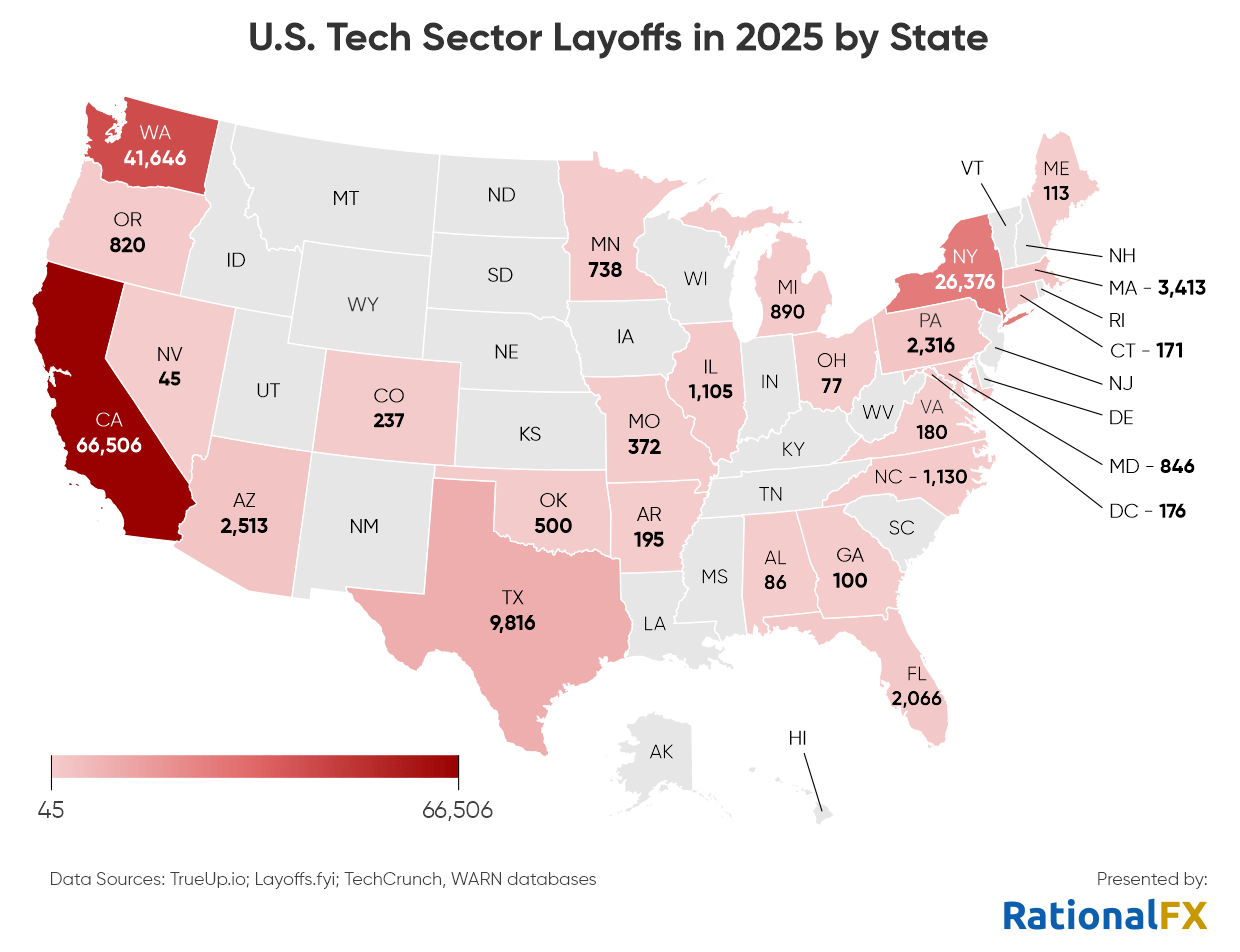Economic uncertainty, high interest rates, and the accelerating shift towards automation and artificial intelligence continue to drive mass layoffs across the tech sector. It’s not just individuals being made redundant; entire roles that were once deemed essential are disappearing from the workforce.
In response to this trend, the team at RationalFX investigated the wave of layoffs, analysing the number of job cuts that have occurred so far in 2025. Based on figures from several sources, including TrueUp, TechCrunch, and multiple state WARN databases, we identified the companies with the most significant workforce reductions. So far in 2025, more than 226 thousand people have been laid off in the global tech sector, and if the trend continues at the same rate, this number will exceed 257,000 by the end of the year.
American companies, in particular, seem to be doubling down on downsizing and cost-cutting efforts, letting go of more than 162 thousand employees not only in the United States but also in their offshore offices and manufacturing plants. The company cutting the most jobs so far in 2025 is Intel, which had close to 109,000 employees at the end of 2024 and, by the end of this year, plans to reduce headcount to 75,000, according to Reuters, effectively slashing more than 30 thousand positions.

With the biggest tech hub in the world being located in the US, it is no wonder that the vast majority of layoffs in 2025 are reported by American companies. Currently, US-based company job cuts account for 71.7% of the 226,647 reported across the globe. Along with Intel, which has been reducing its headcount since last year, other American tech giants to carry out mass cuts are Amazon and Microsoft, two of the world’s largest corporations with trillion-dollar market capitalizations.
India has the second-largest wave of tech layoffs, with Tata Consultancy Services, the largest information technology and services company in the country, announcing 12,000 reductions. This pushes India’s total layoffs to more than 18,000. Panasonic’s recent 4% workforce reduction, affecting 10,000 jobs, has pushed Japan to third place. The Japanese technology conglomerate’s latest layoffs aim to boost profitability and streamline operations.
Accenture’s recent decision to cut 11,000 jobs has propelled Ireland to the forefront of European countries in terms of technology sector redundancies. Earlier in the year, fintech heavyweight Stripe shed approximately 300 roles, while Flutter Entertainment, the major sports betting firm, announced around 200 layoffs over the summer. Taken together, these high-profile job cuts have brought the total number of people affected in Ireland to roughly 11,500.
Switzerland, despite not being among the largest technology hubs in the world, is also one of the countries where some of this year’s most notable mass layoffs are taking place. STMicroelectronics, one of the world’s largest semiconductor manufacturers, announced in January that it would be letting go of around 3,000 employees. In June, the Plan-les-Ouates-based company said it planned to reduce its workforce by 5,000 over a three-year period.
Tech Companies Boost Profits While Trimming Global Workforces
Over the past few years, Microsoft’s revenue has continued to grow steadily. Its first-quarter results for fiscal year 2026, ending 30 September 2025, show revenue of $77.7 billion, up 18% compared with the same quarter last year, and net income of $27.7 billion, a 12% year-on-year increase.
Despite its strong financial performance, Microsoft is still one of the tech companies leading 2025’s wave of layoffs, with management and senior roles far from spared. Since the start of the year, the company has cut over 19,000 jobs, from performance-based reductions in January to significant layoffs in the Xbox division and a May announcement of 6,000 more cuts. Phil Spencer, Xbox’s CEO, framed the changes as part of a broader effort to streamline the business, remove layers of management, and redirect resources toward growth areas such as AI and cloud services.
Even as it posts strong financial results, Meta is facing a significant layoff wave in 2025. In the third quarter of fiscal year 2025, the company generated $51.24 billion in revenue, a 26 percent increase compared with the same quarter last year, and $2.71 billion in net income, despite a $15.93 billion one-time tax charge. Meta’s operating income rose to $20.54 billion, with an operating margin of 40 percent, down from 43 percent a year ago, while total costs jumped 32 percent due largely to the rapid expansion of its AI infrastructure. Even as it invested heavily in AI, including $14.3 billion in June for a 49 percent stake in Scale AI, the company has laid off at least 4,320 employees since the start of the year, highlighting the tension between workforce reductions and major growth investments.
AI & Automation Eliminate Thousands of Positions

As new advances in artificial intelligence and automation technologies are being announced on a weekly basis, many companies have started implementing them to enhance productivity and streamline various processes. While many focus on training their staff to use these technologies, a growing number of businesses decide to replace employees with automation and AI tools. Many tech companies are cutting data-centric roles as they shift their focus toward cloud and AI-related positions, although this trend seems to be spreading way beyond the tech sector.
Hospitality giant Marriott International and Dutch banking corporation ING and just two of the dozens of big players who are now fully leveraging customer service chatbots, for instance. UK telecom BT said it would be cutting 55,000 jobs, with the number representing both hired employees and contractors by 2030. Around 10,000 roles will be filled by AI, while the company is currently focusing on expanding its fiber and 5G technologies, digitizing, and implementing AI. In its latest annual report, it said that 48,000 employees were already actively using AI productivity tools. By the end of March 2025, BT employed around 85,300 people, roughly 6,400 fewer than at the same time in 2024.
In technology, however, these shifts are happening at the speed of light, with some companies already openly replacing human employees with automation tools, chatbots, and enterprise AI. Amazon, the world’s largest retailer and one of the largest tech companies in the U.S., is the latest example of this. On October 28, Amazon confirmed 14,000 job cuts, saying the company was now focusing on AI and adapting to “the most transformative technology we’ve seen since the Internet”, as expressed in a memo to employees. Of the 19 thousand or so layoffs at the company this year, these 14 thousand are directly linked to AI adoption and making the corporate structure “leaner”.
One of the massive waves of layoffs emerging as a result of automation and artificial intelligence tools, as well as a result of relocating operations outside the United States, has been at IBM. The tech giant, which despite its long history in innovation and cutting-edge technology development, seems to be left behind in the race for generative AI. With roughly 9,000 layoffs this year, the Armonk-based company aims at streamlining its operations, cutting costs, and focusing new efforts on quantum computing and artificial intelligence.
Professional services company Accenture has announced a sweeping reduction of 11,000 employees over just three months, a move closely tied to its strategic pivot towards artificial intelligence. The company is executing a US$865 million restructuring plan, which includes severance payouts and divestment of certain business units, to redeploy capital to AI-driven operations and improve operational efficiency. Around 550,000 of the company’s employees have already been trained in generative AI fundamentals, and the firm now employs 77,000 AI and data specialists, which is nearly double the number from two years ago.
Human resources and financial management software company Workday recently laid off 1,750 employees while investing in AI and hiring for AI-focused roles. Duolingo, the popular language learning app, has also reportedly replaced hundreds of positions with AI tools in a ‘strategic shift toward an “AI-first” approach,’ announced by CEO Luis von Ahn in April. Following a huge backlash not just by employees but by customers online, he was forced to clarify that the company would not be laying off employees; rather, a person would be hired only if the AI cannot do the job it is tasked with properly. Over the past year and a half, Duolingo has eliminated hundreds of contractor positions.
Another notable example is Salesforce, which slashed its customer support workforce nearly in half thanks to AI. CEO Marc Benioff recently announced the company was able to reduce its customer support from 9,000 positions to around 5,000 by using AI agents. Chinese company Bytedance, the parent of TikTok, has also eliminated hundreds of roles, putting human jobs in the hands of AI. In early August, 150 employees from the company’s Trust and Safety Department team in Berlin were said to have received termination notices, prompting protests in front of the local office. As part of Bydance’s global shift to replace human moderation with artificial intelligence, another team of content moderators was later laid off in the United Kingdom. It is still unclear how many roles were slashed there, but it is assumed the number is close to that in Germany. Other major tech companies laying off human workers in favor of automation and AI are Cisco, Klarna, and Intuit.
Manufacturing Giants Lead in Tech Layoffs in 2025

Following last year’s 15,000 layoffs, it seems that Santa Clara-based semiconductor and computer components manufacturer Intel is doubling down on cutting jobs as a means to reduce costs. Initially, the company announced that it would be reducing its workforce by a whopping 20% by the end of the year. The news came after a new CEO took over, while the company’s financial woes continued into 2025, when it reported a net loss of $821 million for Q1 and another $2.9 billion in losses for Q2.
From 108,900 employees at the end of 2024, the total headcount is planned to come down to around 75,000 by the end of this year, according to official announcements. This means that in 2025 alone, Intel is laying off roughly 31% of its workforce, or 33,900 employees. Amazon follows as the company with the most job cuts this year – apart from the 14,000 layoffs announced in late October, the retail giant has also let go of another 5,500 or so workers in 2025.
Microsoft has also initiated mass layoffs this year, with the recent layoffs of more than 9,000 individuals described by CEO Satya Nadella as “necessary” for the AI transformation the company is envisioning. July’s announcement of job reductions is just the latest round of layoffs for the tech giant, which is expected to have let go of roughly 19 thousand employees by the end of the year.
In its largest-ever round of layoffs, Verizon has announced its plans to cut 15,000 employees, or around 15% of its workforce, as part of its restructuring plan under the company’s new CEO, Dan Schulman. The move comes amid slowing subscriber growth, intensifying competition from rivals such as AT&T and T-Mobile, and mounting pressure to streamline costs across the business. Much of the reduction will target non-union management roles, while around 180-200 company-owned retail stores will be franchised to reduce fixed costs.
India’s largest IT services company, Tata Consultancy Services, was among the tech giants announcing workforce reductions in July. The company, which is part of the massive business conglomerate Tata Group, said it would be cutting 12,000 jobs, mostly middle and senior-level positions. The move, which will affect roughly 2% of the company’s workforce until April 2026, is not just a result of AI implementation, according to TCS CEO K. Krithivasan; it is part of a larger transformation, aimed at making the company more “agile” and ready for the new technologies that are being constantly developed in the sector. Similar to many others, TCS needs employees with a different set of skills, skills that were not needed just a couple of years ago.
Similar to the rest of the businesses mentioned here, IBM, one of the oldest and largest technology companies in the United States, has recently faced increased operational costs, along with shifting demand and changing market conditions. Although the company has not revealed any details on the laid-off employees, it is believed that the restructuring affected mostly its HR department, as well as marketing teams and financial operations positions: all non-tech jobs that could at least partially be replaced by AI. IBM automated routine HR tasks such as drafting emails, analyzing spreadsheets, and managing internal queries.
Panasonic announced plans to cut 10,000 jobs worldwide as part of efforts to reduce costs and boost profit margins. Microsoft, on the other hand, has announced workforce reductions on two separate occasions in 2025. The first round targeted about 1% of its employees, around 2,000 people, based on performance. Later, the company revealed a second wave of layoffs affecting approximately 6,840 employees, representing roughly 3% of its total workforce.
Social media platform and communication company Meta has reduced the size of its workforce numerous times throughout 2025. A recent wave of layoffs sacked 600 employees across its artificial intelligence division, A.I. Superintelligence Labs, followed by another 100 workers in Reality Labs, the company’s augmented and virtual reality unit. In total, Mark Zuckerberg’s Meta has laid off at least 4,320 jobs since the beginning of the year.
Semiconductor manufacturing and design company STMicroelectronics initially announced plans to lay off 3,000 workers by 2027, but the number later climbed to 5,000. The company’s 2024 annual report reveals that they employ 11,500 in France and 12,700 in Italy. The Italian and French governments own a combined 27.5% share of STMicroelectronics, and there is currently a heavy push from both governments towards limiting the number of layoffs to 1,000 in Rome and the same amount in France. It is unclear how many will be laid off this year, but media reports estimate that between 2,000 and 5,000 employees can lose their jobs.
Swedish battery manufacturer Northvolt had long been struggling financially until, in March, it was forced to file for bankruptcy and cease operations. With most battery production centred in China, Japan, and South Korea, Northvolt was founded as Europe’s answer to reducing its dependence on suppliers from other continents. However, following its collapse, at least 3,000 employees were said to be left jobless, including at Northvolt’s massive factory in Skellefteå.
California & Silicon Valley: A Tech Hub & Centre of Job Cuts

As expected from the state’s high concentration of technological companies, California has spearheaded layoffs in the U.S. tech sector this year, with 66,506 job cuts. These account for roughly 40.9% of all tech layoffs in the country. Companies headquartered in California with the biggest layoffs in 2025 include Intel, Salesforce, Meta, HP, Workday, and Autodesk.
Washington State, another major hub for technology companies, has seen 41,646 tech jobs cut since the start of the year, accounting for 25.6% of all tech layoffs in the U.S. The biggest layoffs in the state of Washington happened at Microsoft, Amazon, Blue Origin, Redfin, and Expedia.
New York State has rapidly climbed the ranks of U.S. states experiencing the highest number of layoffs towards the end of 2025, with 26,376 tech job cuts, the vast majority concentrated in New York City. This represents 16.2% of the total 162,438 layoffs reported across the United States since the start of the year. The company responsible for the most redundancies by a considerable margin in the state is IBM, which has accounted for 9,000 job cuts since January 2025.
In Texas, at least 9,816 jobs have been cut this year across 17 tech companies, including Oracle, Hewlett Packard Enterprise, Indeed, CrowdStrike, Match Group, and Bumble. This significant number of redundancies places Texas fourth among the U.S. states in terms of layoffs, even though its nearly 10,000 job losses account for just around 6% of the national total, showing just how concentrated tech company layoffs are in busier tech hubs such as California and Washington State.
Massachusetts ranks fifth with 3,413 out of all job cuts in the US. The companies with the most layoffs for the state are the following: Wayfair (1,070), Tripadvisor (716), Brightcove (450), and Symbotic (400). Boston has the most layoffs, with six out of the eleven companies headquartered in the city.
The Current State of the Tech Industry in 2025
The tech sector was hit hardest in the aftermath of the COVID-19 pandemic, with nearly a million jobs lost since 2021. In 2025, the ongoing wave of mass layoffs appears to be driven by automation, AI-driven job displacement, and broader cost-cutting strategies. While roles easily replaced by automation were the first to go, Microsoft’s previous round of layoffs of 6,000 employees, including a prominent AI director for the company, show that even senior positions are no longer secure.
Hiring managers are placing greater emphasis on AI development as a core skill when evaluating candidates. Historically, when jobs have been at risk, companies have often turned to reskilling their workforce to help mitigate the impact of potential layoffs. Some executives, such as TCS’s K. Krithivasan, however, say that redeployment and finding new positions for current employees just to avoid layoffs does not work. Only time will tell if tech companies will continue to focus on cost-cutting and downsizing through 2025, or if advancements in AI will lead to the creation of new roles and opportunities in the technology market.
Between January 1 and November 18 of 2025, more than 226,000 employees were laid off in the technology sector. We estimate that every day, 706 workers have lost their jobs on average since the start of the year, and at this pace, the tech industry is set to let go of another 31 thousand people by the end of the year. If the trend progresses, calculations show that the total number of tech sector layoffs in 2025 would exceed 257,000.
Methodology
For this report, the team at RationalFX examined all reported tech-company layoffs since the beginning of 2025, sourced from the IT job portal TrueUp.io. We also searched additional sources, including TechCrunch, Layoffs.fyi, and several WARN databases. These are publicly available announcements providing advance notice in cases of qualified plant closures and mass layoffs as required by the US Worker Adjustment and Retraining Notification (WARN) Act.
Layoff figures were first aggregated at company level to determine the total job cuts per firm. Next, companies were classified by the country in which they are headquartered, providing insight into the geographic distribution of layoffs. To highlight the most significant workforce reductions, firms were ranked by the number of jobs eliminated, while countries were ranked based on the total layoffs reported by companies operating within them.
